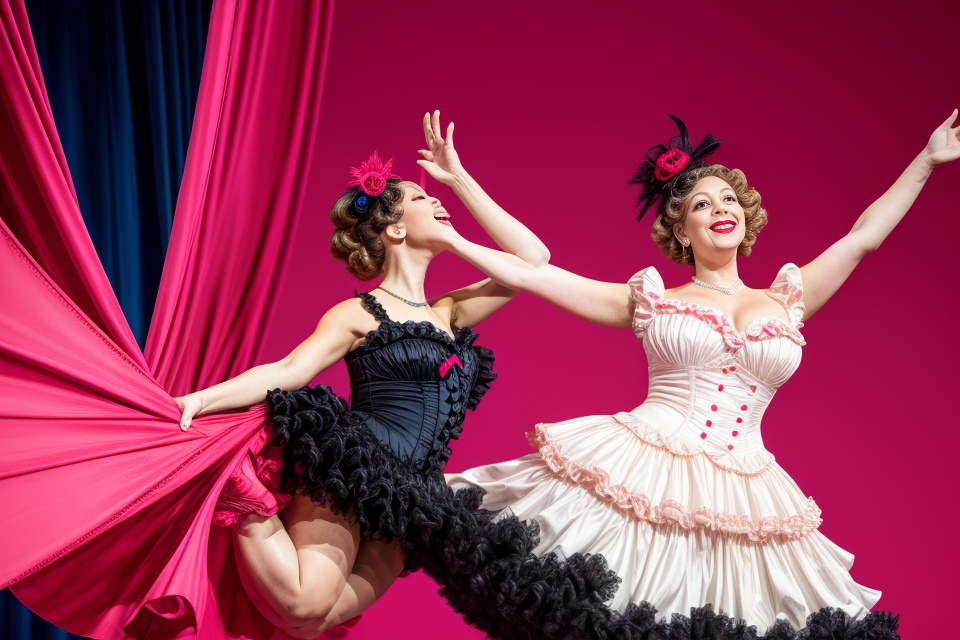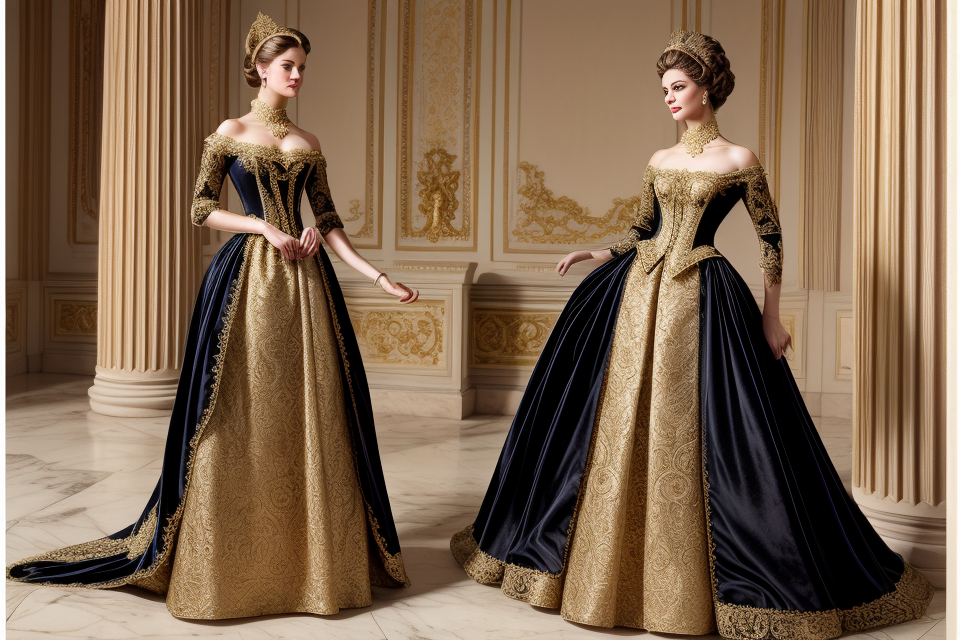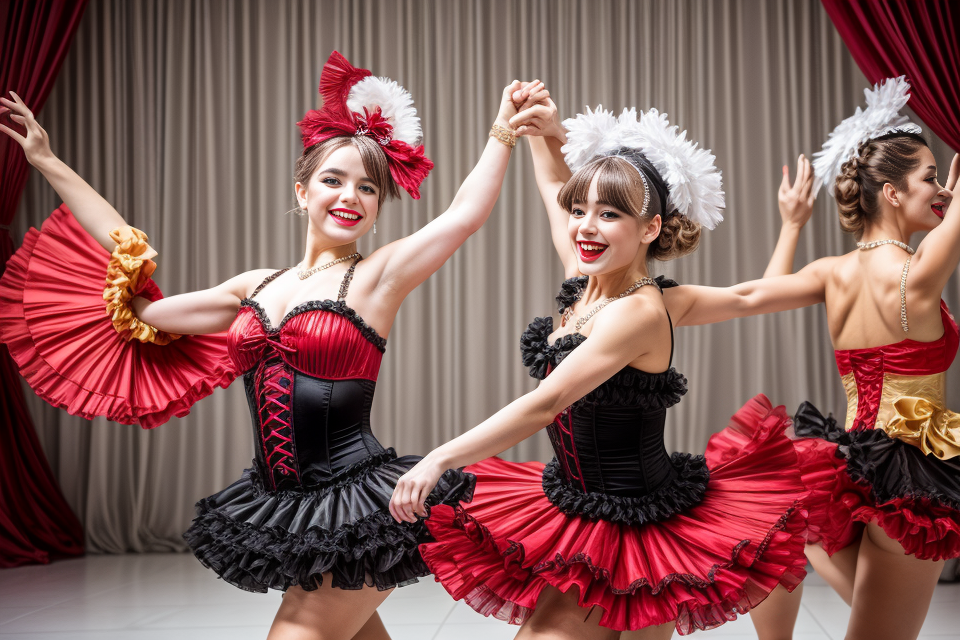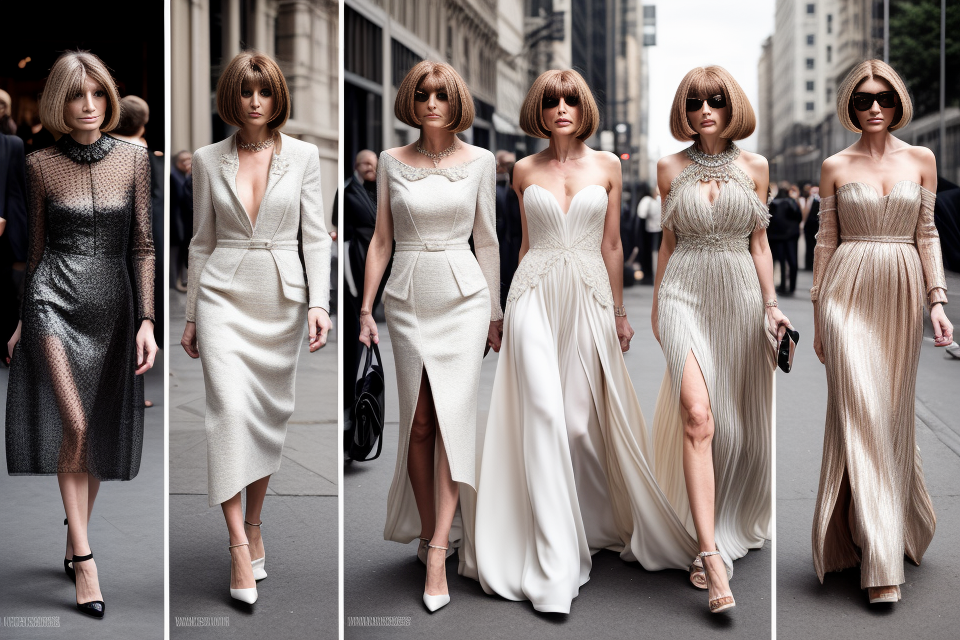Cancan, the iconic French dance and dress, has been captivating audiences for centuries with its lively rhythms and dazzling costumes. But have you ever wondered what makes up this stunning garment? In this article, we’ll take a deep dive into the materials used to create the quintessential cancan dress, exploring its history, construction, and the unique characteristics that set it apart from other styles of clothing. From the delicate lace and tulle to the bold colors and bold designs, we’ll uncover the secrets behind this beloved dance and its signature dress. So, get ready to immerse yourself in the world of cancan and discover what makes this dress so truly extraordinary.
Cancan is a traditional French dance that originated in the 19th century, and the iconic dress associated with it is made of lightweight, flowing materials that allow for ease of movement. The dress typically consists of a loose-fitting top with a low-cut neckline and puffed sleeves, and a full skirt made of several layers of lightweight fabric such as tulle or chiffon. The skirt is often designed to be voluminous and full, with multiple layers of fabric that create a billowing effect when the dancer moves. The fabric used to make the cancan dress is usually lightweight and breathable, with a focus on allowing the dancer to move freely and easily. Some common materials used to make cancan dresses include silk, chiffon, tulle, and organza, although the specific materials used can vary depending on the desired look and feel of the dress.
What is Cancan?
The History of Cancan
The origins of the cancan dance can be traced back to the early 19th century in Paris, France. It was initially performed by working-class women in taverns and cabarets, and it was characterized by its lively and provocative movements. The dance quickly gained popularity and became a symbol of liberation and empowerment for women.
With the rise of the French Cancan, the dance also began to influence fashion, and the Cancan dress became a popular garment among women. The dress was designed to be comfortable and flexible, allowing for the free movement required for the dance.
The Cancan Dress Today
Today, the Cancan dress is a popular fashion statement, and it has evolved significantly from its origins as a dance costume. The dress is characterized by its full skirt, which is typically made of lightweight materials such as tulle or chiffon. The skirt is often layered and frilled, and it is designed to create a full, billowing effect when the wearer moves.
The bodice of the Cancan dress is typically fitted and may be made of a variety of materials, including cotton, silk, or lace. The sleeves are often short and fitted, and the neckline may be low or high, depending on the style of the dress.
Despite its origins as a working-class garment, the Cancan dress has become a popular fashion statement among women of all social classes. It is often worn for special occasions, such as weddings or formal events, and it is also popular as a performance costume for dancers and performers.
Materials Used in Cancan Dresses
Cancan dresses are typically made from lightweight, flowing fabrics that allow for freedom of movement and a sense of playfulness. Some of the most common fabrics used in cancan dresses include:
Tulle
Tulle is a sheer, mesh-like fabric that is often used as an overlay or underlayer in cancan dresses. It is lightweight and provides a subtle texture and layer of depth to the dress.
Organza
Organza is a lightweight, crisp fabric that is often used for the skirt of a cancan dress. It has a stiff, slightly crinkled texture that adds volume and movement to the skirt.
Chiffon
Chiffon is a soft, lightweight fabric that is often used for the top of a cancan dress. It has a delicate, flowing texture that allows for a sense of movement and fluidity.
Satin
Satin is a smooth, lustrous fabric that is often used for the lining of a cancan dress. It provides a sleek, polished look and feel, and helps the dress slide easily over the body.
Charmeuse
Charmeuse is a soft, luxurious fabric that is often used for the cuffs or hem of a cancan dress. It has a subtle sheen and a silky texture that adds a touch of elegance to the dress.
In addition to these common fabrics, cancan dresses may also be adorned with a variety of embellishments and accessories, such as:
- Lace: delicate, eyelet-style lace can be used to add a touch of femininity and texture to the dress.
- Beads: small, sequin-style beads can be used to add sparkle and shine to the dress.
- Sequins: larger, metallic sequins can be used to add a touch of glamour and shine to the dress.
- Feathers: soft, delicate feathers can be used to add a touch of whimsy and playfulness to the dress.
- Ribbons: narrow, satin ribbons can be used to add a touch of elegance and detail to the dress.
The Importance of Layers in Cancan Dresses
In the world of fashion, the cancan dress has become an iconic symbol of femininity and grace. These dresses are renowned for their flowing skirts and dazzling displays of movement, which are made possible by the strategic use of layers. Layers are a crucial component of cancan dresses, as they provide structure, support, and movement to the garment.
One of the primary reasons why layers are so important in cancan dresses is that they help to create a structured, yet flexible, silhouette. Without layers, the dress would be limp and unshapely, lacking the defined curves and lines that are synonymous with the cancan style. By incorporating multiple layers of fabric, the dress is able to maintain its shape and structure, even when the wearer is in motion.
Moreover, layers in cancan dresses play a critical role in enhancing the overall look of the garment. The multiple layers of fabric create a dynamic visual effect, with each layer adding depth and dimension to the dress. This creates a sense of movement and fluidity, which is essential to the cancan style. Additionally, the different colors and patterns of the layers can create a stunning visual effect, with each layer complementing and enhancing the others.
There are several types of layers that are commonly used in cancan dresses, each with its own unique properties and benefits. Some of the most popular types of layers include:
- Flounces: These are light, flowing layers of fabric that are designed to create a sense of movement and fluidity. Flounces are often used in the skirt of the dress, where they can create a stunning visual effect as the wearer moves.
- Petticoats: These are layers of fabric that are worn underneath the dress, providing support and structure to the garment. Petticoats are typically made from heavier fabrics than the layers of the dress itself, and are designed to hold the dress in place and prevent it from becoming disheveled.
- Ruffles: These are delicate, frilly layers of fabric that are often used to add a touch of femininity and grace to the dress. Ruffles can be incorporated into the skirt or the bodice of the dress, and can be made from a variety of fabrics, including lace and chiffon.
Overall, the use of layers in cancan dresses is essential to the overall look and feel of the garment. Without layers, the dress would lack structure, support, and movement, and would not be able to achieve the stunning visual effect that has made the cancan style so iconic. By incorporating multiple layers of fabric, cancan dresses are able to create a sense of movement, fluidity, and femininity that is unmatched by any other style of dress.
The Role of Color in Cancan Dresses
Color plays a significant role in the overall look and feel of a cancan dress. It is used to create contrast, draw attention to certain areas, and express the mood and theme of the performance. There are several classic colors that are commonly used in cancan dresses, such as black, white, and red. These colors are often used to create a bold and striking look, and they can be used in combination with other colors to create a more vibrant and dynamic appearance.
In addition to classic colors, cancan dresses may also feature bold and bright colors such as pink, green, and yellow. These colors can be used to create a more playful and whimsical look, and they can be used to draw attention to certain areas of the dress or to create a more striking overall appearance. The use of color in cancan dresses can greatly affect the overall look and feel of the dress, and it is an important consideration for anyone who is creating or performing in a cancan dance.
The Construction of a Cancan Dress
The Basics
Creating a cancan dress involves several basic steps that require careful attention to detail. These steps include cutting the fabric, gathering and pleating, and attaching the layers.
Cutting the Fabric
The first step in creating a cancan dress is to cut the fabric. This is typically done using a pattern that has been specifically designed for the cancan dress. The pattern will dictate the shape and size of the dress, as well as the placement of the gathering and pleating.
When cutting the fabric, it is important to use sharp scissors or a rotary cutter to ensure a clean and precise cut. The fabric should be cut along the lines indicated by the pattern, taking care to avoid any wrinkles or puckers.
Gathering and Pleating
Once the fabric has been cut, the next step is to gather and pleat it. Gathering involves pulling the fabric together at specific points to create volume, while pleating involves folding the fabric in a specific way to create a ruffle effect.
To gather the fabric, a gathering stitch is used to create a gathered seam. This is typically done using a sewing machine, although it can also be done by hand. The stitches should be evenly spaced and should pull the fabric together in a consistent manner.
Pleating is typically done by hand, using a special pleating foot on a sewing machine. The fabric is folded in a specific way to create a ruffle effect, with each pleat being carefully spaced and positioned.
Attaching the Layers
Once the gathering and pleating has been completed, the next step is to attach the layers of the dress. This typically involves sewing the top layer of fabric to the bottom layer, using a sewing machine or by hand.
When attaching the layers, it is important to take care to align the pleats and gathering correctly. This can be a time-consuming process, as each pleat and gathering must be carefully positioned and secured in place.
Overall, the construction of a cancan dress requires a great deal of attention to detail and a solid understanding of basic sewing techniques. By following these basic steps, it is possible to create a beautiful and unique cancan dress that is sure to turn heads.
Advanced Techniques
Adding Beading and Sequins
One of the most popular advanced techniques used in the construction of a cancan dress is the addition of beading and sequins. These decorative elements are added to the dress to create a more elaborate and visually appealing design. The beading and sequins are usually added to the hemline, bodice, and sleeves of the dress, and they can be made from a variety of materials, including glass, plastic, and metal.
Attaching Feathers and Other Accessories
Another advanced technique used in the construction of a cancan dress is the attachment of feathers and other accessories. These accessories are added to the dress to create a more dramatic and flamboyant design. The feathers and other accessories are usually attached to the hemline, sleeves, and neckline of the dress, and they can be made from a variety of materials, including feathers, beads, and sequins.
Creating a Custom Lining
A custom lining is another advanced technique used in the construction of a cancan dress. The lining is usually made from a different material than the dress itself, and it is used to add structure and support to the dress. The lining is also used to hide any raw edges or seams on the dress, and it can be made from a variety of materials, including cotton, silk, and nylon.
Cancan Dress Care and Maintenance
Basic Tips
- Dry cleaning only: The delicate fabric of the cancan dress requires special care when it comes to cleaning. Dry cleaning is the recommended method to keep the dress looking its best. This method uses a solvent to remove dirt and stains without causing damage to the material. It is important to take the dress to a reputable cleaner who is experienced in handling delicate fabrics.
- Storing in a protective garment bag: When not in use, it is important to store the cancan dress in a protective garment bag. This will help to prevent damage to the material and maintain its shape. The bag should be made of a soft, breathable material that will not damage the dress. It is also a good idea to store the dress in a cool, dry place to prevent moisture buildup.
- Spot cleaning when necessary: While dry cleaning is the recommended method for cleaning the cancan dress, there may be times when spot cleaning is necessary. In these cases, it is important to use a mild detergent and clean the stain gently. Avoid using harsh chemicals or abrasive cleaners, as these can damage the material. It is also important to avoid rubbing the stain, as this can cause it to spread. Instead, blot the stain gently with a clean cloth until it is removed.
Advanced Tips
Repairing minor damage
- Hemlines: A common issue with cancan dresses is a frayed hemline. To repair this, gently tug on the loose threads until they are even with the rest of the hem. For more severe damage, consider using fabric glue or sewing the hem closed.
- Straps: If the straps have become frayed or damaged, carefully trim the excess threads and replace them with new ones. Use strong thread that matches the color of the dress to blend in seamlessly.
- Rips and tears: For small rips and tears, apply fabric adhesive or a patch to repair the damage. Be sure to choose a patch that matches the color of the dress as closely as possible.
Refreshing the look with a steam iron
- De-wrinkling: If your cancan dress has become wrinkled, use a steam iron to refresh its look. Be sure to use a low heat setting and a press cloth to protect the delicate fabric.
- Removing creases: For particularly stubborn creases, try using a damp cloth to gently smooth out the fabric before ironing.
Reviving worn or faded areas with fabric dye
- Identifying the color: Before you start, make sure you know the original color of the dress. This will help you choose a dye that matches as closely as possible.
- Removing old dye: If the fabric has previously been dyed, use a dye remover to ensure the new dye takes properly.
- Applying the dye: Follow the instructions on the fabric dye packet for the best results. It’s generally recommended to apply the dye to a small, inconspicuous area first to ensure the color is a good match. If the color is not a good match, try a different dye or use a color corrector to remove the old color before dyeing.
By following these advanced tips, you can keep your cancan dress looking its best for years to come.
Cancan Dresses: Timeless and Iconic
The Enduring Appeal of Cancan Dresses
Cancan dresses have been a staple of women’s fashion for over a century, and their enduring appeal is a testament to their timeless design and versatility. The simple yet elegant silhouette of the dress, coupled with its signature high-low hemline, has made it a popular choice for a variety of occasions, from casual outings to formal events.
Famous Wearers and Appearances
Throughout the years, many famous women have been photographed wearing Cancan dresses, solidifying their status as an iconic piece of clothing. From Audrey Hepburn in “Sabrina” to Marilyn Monroe in “Gentlemen Prefer Blondes,” the Cancan dress has been worn by some of the most iconic actresses of all time.
In addition to its use in film and television, the Cancan dress has also made appearances on the runway and in high-fashion editorials. Designers such as Chanel and Dior have incorporated the Cancan dress into their collections, showcasing its versatility and timeless appeal.
Future Trends and Evolution of the Cancan Dress
As fashion trends come and go, the Cancan dress remains a timeless classic. However, it is important to note that fashion is constantly evolving, and the Cancan dress is no exception. Designers are constantly experimenting with new materials, silhouettes, and styles, pushing the boundaries of what a Cancan dress can be.
One trend that has emerged in recent years is the use of sustainable materials in Cancan dresses. Designers are incorporating eco-friendly fabrics such as organic cotton and recycled polyester into their collections, offering consumers a more sustainable option for this iconic dress.
Another trend that is gaining popularity is the use of bold and bright colors in Cancan dresses. Designers are experimenting with bright hues and bold patterns, adding a modern twist to this classic dress.
Overall, the Cancan dress is a timeless and iconic piece of clothing that has withstood the test of time. Its enduring appeal and versatility make it a popular choice for women of all ages, and its future evolution is sure to be exciting to watch.
FAQs
1. What is Cancan made of?
Cancan is a type of dress that is traditionally made of a lightweight, crinoline fabric. This fabric is made from a combination of cotton and nylon, which gives it its characteristic stretch and flexibility. The fabric is typically woven in a ribbed or matte finish, which gives it a slightly textured appearance. The specific blend of cotton and nylon used in the fabric can vary depending on the brand and style of the dress.
2. What is crinoline fabric?
Crinoline fabric is a type of lightweight, cotton-based fabric that is used to make dresses such as cancans. It is made from a blend of cotton and nylon, which gives it its characteristic stretch and flexibility. The fabric is woven in a ribbed or matte finish, which gives it a slightly textured appearance. Crinoline fabric is known for its lightweight and breathable properties, making it a popular choice for summer dresses.
3. What is the difference between cancan and other types of dresses?
The main difference between cancan and other types of dresses is the way it is constructed. Cancans are made using a technique called “caning,” which involves sewing a series of horizontal rows of fabric around the skirt to create a ruffled effect. This gives the dress its characteristic fullness and volume. In contrast, other types of dresses such as A-line dresses or sheath dresses are typically cut from a single piece of fabric and do not have the same level of volume or fullness.
4. Cancan dresses come in different colors?
Yes, cancan dresses come in a variety of colors and patterns. They are often available in bright, bold shades such as red, pink, and yellow, as well as more muted tones like black, white, and beige. Some cancan dresses may also feature intricate patterns or designs, such as polka dots or florals. When choosing a cancan dress, it’s important to consider the occasion and your personal style when selecting a color and pattern.



